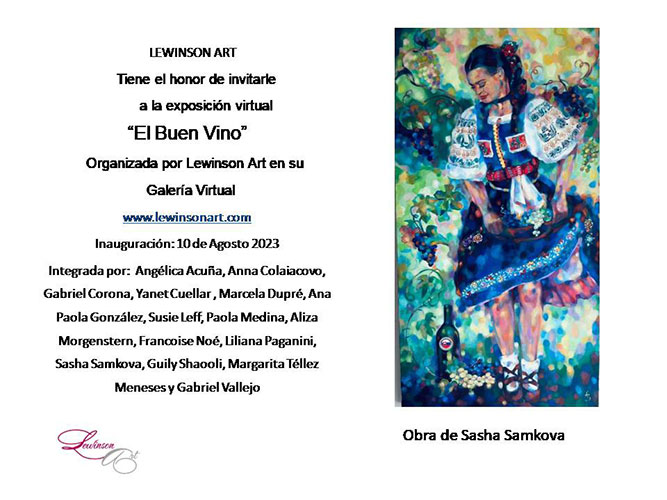Art, // August 6, 2023
Virtual exhibition — “The Good Wine”
Lewinson Art presents a Virtual Exhibition – “The Good Wine”
Lewinson Art is dedicated to promoting artists through its virtual Gallery www.lewinsonart.com and organizing both virtual and face-to-face exhibitions in different spaces.
On this occasion, it invites artists to participate in the virtual exhibition “El buen vino”, a very interesting topic, since it refers to everything from the vineyards and the grapes with which the wine is made, to the bottles and glasses with which we toast on special occasions, or the accompaniment that we give to food when drinking a good wine.
Wine was produced for the first time during the Neolithic age, according to archaeological evidence found in the Zagros Mountains, in the region now occupied by Iraq and Iran, thanks to the presence of Vitis vinifera sylvestris and the appearance of ceramics during this period. The oldest evidence of wine production and consumption is a vessel from the year 5400 BC, found in the Neolithic town of Hajji Firuz Tepe, in the Zagros Mountains. The vessel contains a reddish residue, presumably wine. Although the oldest known cellar has recently been found, dating to 8000 BC, the oldest production of wine is located in Georgia. Subsequently, the consumption of wine spread to the west, reaching Anatolia and Greece; and towards the south, reaching Egypt, already famous in Bahariya during the Middle Kingdom (20th century BC). The oldest Greek documentation on the care of the vine, the harvest and the pressing of the grapes, in Hesiod’s Works and Days, from the 8th century BC. In ancient Greece, wine was drunk mixed with water and it was kept in goat skins.
The first thing that should be noted is that wine, throughout history, has been highly regarded by Western high society, where there is evidence of its production in the 3rd century BC. Since then it has been an essential witness in any event or banquet of importance and around it the great treaties and historical events of the West have been signed.
Already in Egypt, Greece and Rome, Dionysus or Bacchus (god of the vineyards) was worshiped and the Bible refers to wine in various passages, among others where it recounts the last supper of Jesus. We know that in China, 4,000 years ago, they already knew about the fermentation process of the grape, and that in Egypt, in the fourteenth century BC, they already knew about viticulture.
Viticulture owes its further development to the spread of Christianity, as it is the necessary wine for the celebration of mass. The monasteries, with their own production and extraction methods, were the precursors of winemaking, leaving traces as clear as priory wines, coming from the word prior.
Few drinks are as associated with the history of humanity as wine is, and even less with the history of art. It is possible to find frescoes from ancient Egypt representing everyday scenes associated with the world of wine (such as the treading of grapes). In ancient Greece, there were sculptures and paintings depicting grape harvest scenes, as well as a multitude of works dedicated to Dionysus, the god of the grape harvest and wine, the inspiration for ritual madness and ecstasy.
For centuries, grapes and wine have posed countless times for painters and sculptors who represented them in a multitude of shapes and tastes. Artists such as Rubens, Titian, Leonardo Da Vinci, Miguel Ángel, Velázquez, Goya, Van Gogh, Picasso, Andy Warhol, and Botero have been inspired by the grape, wine and all its symbols throughout history.
The artists that make up this exhibition are:
Angélica Acuña, Anna Colaiacovo, Gabriel Corona, Yanet Cuellar, Marcela Dupré, Ana Paola González, Susie Leff, Paola Medina, Aliza Morgenstern, Francoise Noé, Liliana Paganini, Sasha Samkova, Guily Shaooli, Margarita Téllez Meneses and Gabriel Vallejo.
All of them with great creativity and talent interpreted this interesting subject, in different techniques such as painting, digital art and photography, in different styles, achieving a whole range of shapes and colors that convey many emotions.
This exhibition opens on August 10 in my virtual gallery and can be appreciated from the comfort of your homes worldwide. The exhibition will remain until September 30.
Do not miss it.
Deborah Lewison
Débora Lewinson is our main correspondent for Arts Illustrated in Mexico City.
Lewinson Art is dedicated to promoting artists through individual and collective exhibitions in different spaces, as well as a Virtual Gallery that allows the dissemination of art in Mexico and abroad.



